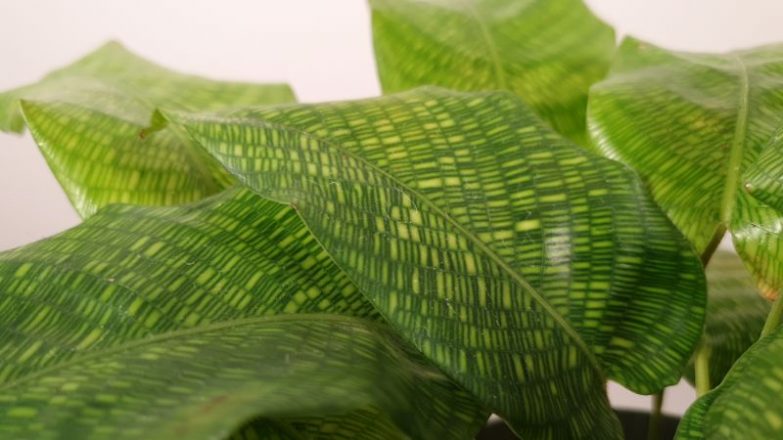Calathea musaica (officially called Goeppertia kegeljanii) combines stunningly intricate foliage, and easier care requirements than many other Calatheas, making this a wonderful houseplant to grow. This article covers everything you need to know about Calathea musaica care to keep your plant thriving year after year.
Calathea musaica care requirements include bright, indirect light, humidity of 50-80%, and well-draining soil that is kept lightly moist at all times. Ensure temperatures are kept between 65-85°F(18-30°C), avoid drafts, and fertilize lightly every 4-6 weeks during spring and summer.
Calathea Musaica Overview
Originating from Brazil, and first documented as Maranta bella by William Bull in 1875, this member of the Marantaceae family is less widely available than some other Calatheas, but it’s a joy to grow and I’d thoroughly recommend picking one up.
Most Calatheas are adorned with stunning, attention-grabbing foliage, combined with challenging care requirements. Calathea musaica is a little more understated, but no less beautiful in my opinion. Thankfully, it’s a little easier to care for than some of its demanding cousins.
With mid-green, gently arching, slightly glossy leaves patterned with the most interesting and beautiful criss-cross, or mosaic pattern, it’s not hard to see why the common name “Network” was coined.
The name Calathea musaica is used commonly in the houseplant trade, as are the names Calathea ‘Network’ and Network Prayer Plant. However, the official name of this plant is Goeppertia kegeljanii. As with so many plants, there are a whole host of other names that this plant has been given previously.
- Calathea bella
- Maranta bella
- Maranta tessellata
- Goeppertia kegeljanii
- Calathea musaica
- Calathea ‘Network’ (Common Name)
- Network Prayer Plant (Common Name)
To keep things simple, I’ll stick with Calathea musaica as this is the name you’re most likely to see when looking for this plant.
Calathea Musaica Care Summary
| Scientific Name | Goeppertia kegeljanii (Calathea musaica is an accepted synonym) |
| Origin | Brazil |
| Light Requirements | Bright, indirect light, although will tolerate a greater range of lighting than some other Calatheas. |
| Watering | Water thoroughly once the top inch of soil feels dry. Make sure to let the pot drain thoroughly after watering. |
| Soil | Well-draining, but moisture-retentive soil. A mix of 2/3 peat or coco-coir and 1/3 perlite is a good option. |
| Temperature | 65°F (18ºC) to 85°F (30°C). Will stop growing below 60°F (15°C). |
| Fertilizer | Fertilize with a balanced preparation every 4-6 weeks during Spring and Summer. |
| Humidity | >50%, but 60-80% is ideal. |
| Flowering | Doesn’t often flower indoors. Insignificant white flowers on short stalks grow directly from the rhizome. |
| Pruning | Minimal pruning requirements. Remove dead or damaged foliage just above soil level. |
| Propagation | Propagate by division of the rhizome. |
| Re-Potting | Only repot if growth is restricted or becomes very pot-bound. |
| Diseases and Pests | Prone to pests including spider mites, mealybugs, thrips, scale, and fungus gnats. Quite resistant to disease unless overwatered. |
| Toxicity | Non-toxic |
| Where To Buy | Buy Calathea musaica online at Etsy (I buy most of my houseplants from Etsy). |
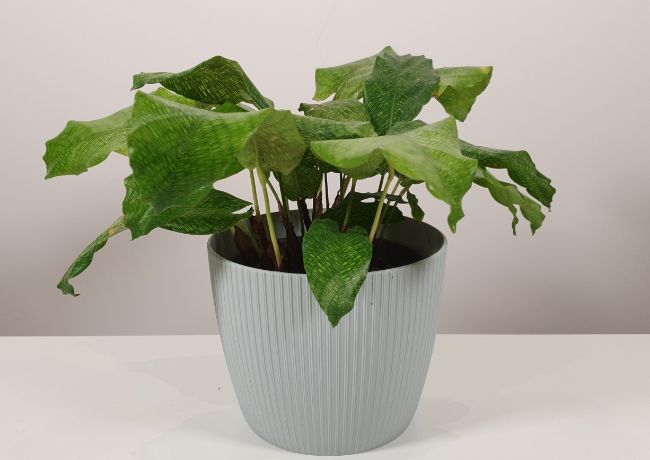
Calathea Musaica Light Requirements
Calathea musaica will do best if it is kept in bright, indirect light, although it is a bit more tolerant of variable lighting than other Calatheas. A little direct sunlight in the morning or late evening is unlikely to do any harm, but more intense direct sunlight will scorch the leaves.
Lighting for Calatheas is a balancing act, as you want to provide sufficient light to promote healthy growth, while keeping the leaves in perfect condition. You can read this article about light requirements for indoor plants to learn more.
Bear in mind that as the seasons change, you may have to move your Calathea musaica to make sure lighting is optimal. A north-east facing windowsill might be perfect in winter, but will provide too much bright sunlight in summer.
Keep an eye on the leaves, and at the first sign of brown patches or edges, have a think about whether the lighting is right.
One interesting thing to note about light is how amazing Calathea musaica looks when light shines through the leaves. Hold your plant up to the light and look from the underside of the leaves to view the mosaic leaf patterning in its full glory.
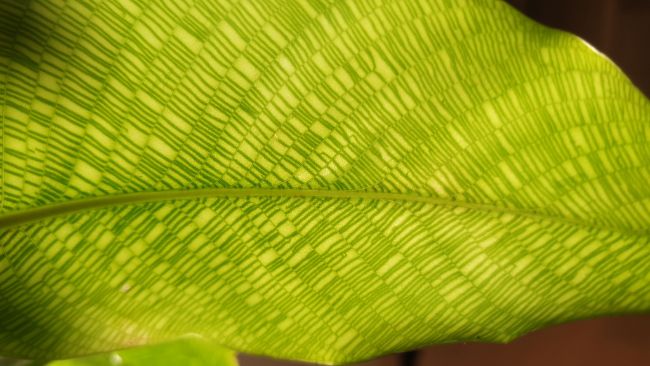
Watering
Calathea musaica will do best in lightly moist conditions, so it’s important to keep a close eye on watering to get the best from this plant. Check your plant every few days and only water once the top inch of soil feels dry to the touch.
Once your plant needs watered, soak the soil thoroughly, until water runs freely from the drainage holes. Make sure to let the excess water drain from the pot for at least a few minutes to ensure the roots at the bottom of the pot are not left sitting in water.
As with lighting, watering is also a balance. Calathea musaica will wilt badly if the soil is left to dry out, but it also has delicate roots that are prone to root rot if it is left in soggy conditions. Read this article to learn the best ways to tell when your houseplants need water.
Calathea musaica is a little more resilient to imperfect watering than some other Calatheas, so this is a good plant to opt for if you aren’t sure about whether Calatheas are too demanding for your liking.
Water Sensitivity
Whilst most houseplants aren’t fussy about what type of water is used to water them, Calatheas can be sensitive to water that is high in chloramines, fluoride, or certain dissolved minerals.
Again, the slightly waxier leaves of Calathea musaica are more resilient to imperfect water quality than some Calatheas, but this is still something you should consider if you are running into problems.
Look out for brown tips or leaf edges in a plant that is being grown in otherwise good conditions. Bear in mind though, that many other issues can also cause similar symptoms, so make sure you have the basics right before worrying about what type of water you are using.
Switch to rainwater or distilled water to water your Calathea musaica if you are having difficulties and observe to see what happens to the new leaves as they deveop.
Calathea Musaica Soil Requirements
Calathea musaica requires well-draining, but moisture-retentive soil. Most houseplant potting mixes will work ok for Calathea musaica, but I normally recommend adding some form of drainage amendment, such as coarse sand, perlite, or gravel, to improve drainage, and reduce the risk of overwatering.
My preferred potting mix for Calathea musaica is two parts peat or coco coir and one part perlite. Read more about choosing and making houseplant potting mix here.
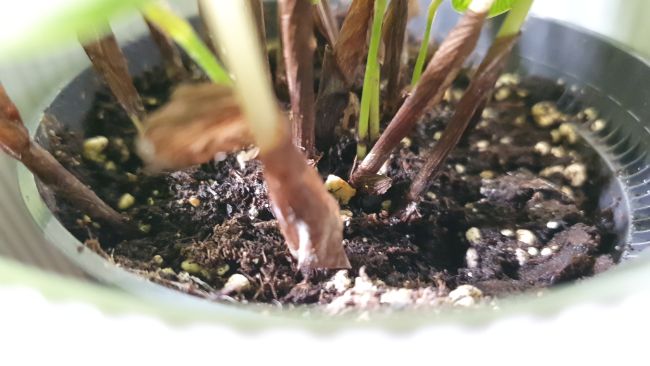
Humidity Requirements
High humidity is a crucial element of Calathea musaica care, and is essential to keeping your plant in good condition. Low humidity will cause the leaves to lose excess water, resulting in brown leaf tips and edges, and even curling of the leaves.
It is best to keep humidity above 50%, but higher levels are even better. The only caveat to this is that very high humidity levels can increase the risk of fungal and bacterial disease if ventilation is insufficient. If humidity is >80%, consider positioning a fan in the same room as your plants to improve air circulation.
I like to use a digital humidity meter (hygrometer) to monitor humidity levels in my home, so I can adjust it as needed. I find it so useful in helping me keep the conditions just right for my plants. This is the one I use.
It can be difficult to achieve humidity of even close to 50% in arid climates or in centrally heated houses in winter. There are a few things that can help to keep things comfortable for your plants.
- Group your plants together. Water evaporating from the soil and transpiration from the foliage will increase local humidity.
- Position one or more dishes of water next to your plant. The increased evaporation of water will improve humidity.
- Use a humidifier to quickly and easily increase humidity to your desired level.
- Avoid misting your plants, as this is relatively ineffective, and can actually increase the risk of fungal and bacterial foliage diseases.
- Read more about improving humidity for houseplants here.
Temperature Requirements
Calathea musaica will thrive in normal indoor temperatures of 65°F (18ºC) to 85°F (30°C), but will generally stop growing below 60°F (15°C), and can show signs of distress when temperatures fall much below this level.
The main temperature issue that you will have to be careful about is drafts. Both hot and cold drafts can cause significant damage to your Calathea musaica, resulting in wilting, and browning leaves.
Take care to keep your plant away from sources of heat, such as radiators and heating vents, and keep clear of drafts windows and air conditioning vents.
How To Fertilize Calathea Musaica
A little fertilizer can make a big difference in the health of your Calathea musaica, but it’s important not to go overboard. There are two options when it comes to fertilizing.
Option 1 – Add nutrients to the soil when potting your plant. 10% compost or worm castings added to the potting mix can provide sufficient nutrients for at least 1-2 years and carries almost no risk of nutrient burn. The drawback of this is that increased organic material in the potting mix will impair drainage, increasing the risk of overwatering.
Option 2 – Fertilize your Calathea musaica on a regular basis with water-soluble plant fertilizer. This is my preferred option and I use a balanced, water-soluble plant fertilizer made up at about 1/4 to 1/2 the strength recommended for outdoor plants. I apply this every 4-6 weeks during spring and summer and avoid fertilizing in fall and winter.
Organic fertilizers typically release their nutrients more slowly, but there is less certainty about the nutrient content of the preparation. Synthetic fertilizers provide more certainty, usually act quicker, but you need to be very careful not to overfertilize. Read my guide to fertilizing houseplants for more information.
Fertilizer salts can accumulate in the soil over time and this can impact the health of your plant, damaging both the roots and foliage. You may notice salt deposits accumulating on the soil surface over time.
It is usually a good idea to flush the soil thoroughly with water every few months to rinse any excess fertilizer salts out of the soil.
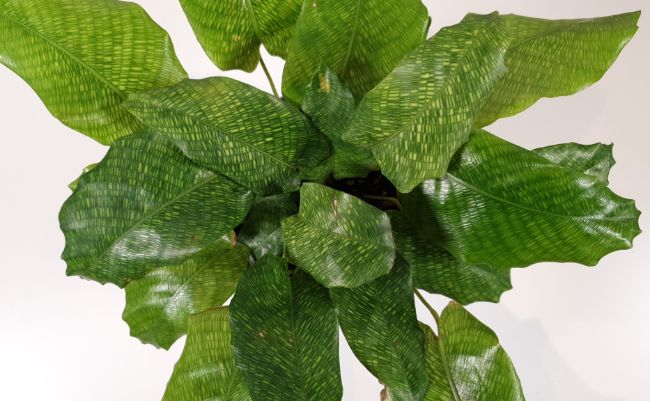
Flowering
Calathea musaica doesn’t often flower indoors, and the blooms aren’t very exciting when they do arrive. They produce white flowers on short stalks that last for a few weeks that emerge directly from the rhizome. As the flowers are produced underneath the foliage, they are easy to overlook.
Pruning
Calathea musaica has very low pruning requirements, and you’ll only need to remove dead or damaged leaves intermittently. The best way to do this is to cut them off just above the soil level with sterile, sharp pruning snips.
Repotting
As Calathea musaica grows from a rhizome that slowly expands over time, the plant can start to get rootbound after 2-3 years in the same pot. Don’t rush to repot though, as they can be a bit sensitive to the move, and tolerate being rootbound quite well.
Repotting is generally a good idea if you would like your plant to grow bigger, or if you notice that the soil is drying out very quickly after watering.
How To Repot Calathea Musaica
- Gently slide the plant out of its existing pot
- Examine the roots to check their health. Any unhealthy leaves should be pruned off at this stage with sterile pruners. Examining the roots will give you a good idea of how happy the plant has been with your care regime.
- Avoid disturbing the rootball too much if everything looks healthy as excessive disruption of the rootball can cause transplant shock after repotting.
- Choose a new pot that is only 1-2 inches larger than the previous one. Picking an excessively large pot greatly increases the risk of overwatering. Make sure the pot has plenty of drainage holes.
- Add a small amount of potting mix to the bottom of the new pot and position your plant in the center of the pot. The aim of this part is to get the level of the plant right in the pot.
- Add further soil around the sides to fill the pot with soil and support the plant. Avoid compressing the soil excessively, as this will reduce aeration and drainage.
- Water the plant lightly. I typically don’t water too much at this stage, as sometimes the roots take a while to start functioning efficiently after repotting, and soaking the soil too much can increase the risk of root rot.
How To Propagate Calathea Musaica
The best way to propagate Calathea musaica is by the division of a mature plant. Carefully divide the rhizome into two or more sections at the time of repotting. You should be able to separate most of the rhizome gently with your fingers.
Be aware that dividing the rhizome of a Calathea musaica or any other Calathea is traumatic for the plant. The likelihood is that your divided plant will stop growing for at least a month or two after division and will need good care to ensure that it survives the process unscathed.
Calathea Musaica Care Tips
These are my top tips for keeping your Calathea musaica (Goeppertia kegeljanii) in top condition;
- Watering, humidity, and lighting are crucially important to keeping your Calathea musaica in good condition. Focus on these aspects of care above all others.
- Humidity levels can change significantly depending on the weather, season, and numerous other factors. Monitoring humidity is hugely helpful.
- Check your plant closely for pests on a regular basis, as early detection and treatment are crucial to prevent major damage to your plant.
- Brown leaves can be due to multiple issues, including low humidity, underwatering, overfertilization, excess direct sunlight etc. Consider all aspects of care when you identify this problem.
- Avoid getting the foliage wet, as this can increase the risk of disease. This is not a problem outdoors, but reduced ventilation indoors greatly decreases the evaporation of excess water.
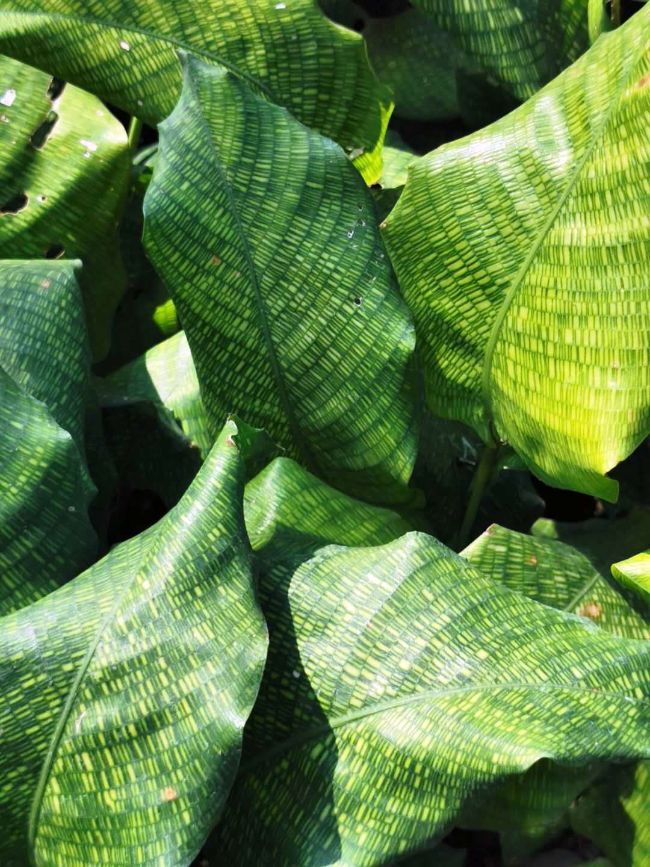
Pests
In addition to being more challenging to keep in good condition, Calathea musaica is also prone to quite a number of common houseplant pests, including spider mites, mealybugs, thrips, fungus gnats, and scale.
Pests are most likely to affect plants that are weakened due to poor care, so keeping your plant in good health will help to reduce the risk of pest problems in the first place.
Most pests can be seen easily if you inspect your plants on a regular basis. I normally check my plants every few days to see if they need watered, and I take this opportunity to inspect them closely for any signs of pests.
It’s really important to look at both sides of the leaves, along the stems, and also in the soil for any sign of pests.
Spider mites are particularly difficult to spot, and the first sign will likely be fine wispy webs spun across and between the leaves. I have lost a number of Calatheas to spider mites due to being less attentive than I should have been, so really do pay attention.
If you spot any pests on your Calathea musaica, the first step is to isolate it from your other plants. The next step is to manually remove as many pests as possible. You can use a damp cloth or wash your plant down with a showerhead or hose. Make sure not to damage the leaves by spraying water too forcefully.
After removing all visible pests, I recommend using a dilute spray of neem oil, horticultural soap or isopropyl alcohol to kill any remaining pests. You may like to try treating a small area of your plant to ensure you do’t damage the foliage.
Keep your plant separated from the rest of your houseplants and re-treat at weekly intervals until you’re sure your plant is bug-free.
I’ve written a complete guide to identifying, treating and preventing common houseplant pests, which covers everything you need to know about the subject of these unwelcome visitors.
Diseases
Thankfully, Calathea musaica isn’t particularly prone to any specific houseplant diseases, other than those caused by imperfect growing conditions. The main way to prevent diseases is to avoid overwatering and ensure good ventilation in the room your Calathea musaica is growing in.
Toxicity
Calathea musaica is non-toxic and safe for humans and pets.
Calathea Musaica Size
Calathea Musaica grows to a mature size of about 2 feet tall and 2-3 feet wide. It is usually smaller than this when purchased as a houseplant and grows relatively slowly.
Last Word
I’ve generally found Calathea musaica (Goeppertia kegeljanii ‘Network’) to be one of the easier Calatheas to care for and keep looking well. I love the mosaic-patterned leaves that are unlike any other houseplants I own.
Hopefully, this article has covered everything you need to know about Calathea musaica care to keep your plant thriving and looking beautiful in your home for years to come.
If you’d like to learn more, I’ve covered Calathea care and common problems in several other articles listed below.
- 12 Stunning Calathea Varieties You Will Love.
- How To Propagate Calatheas.
- Why Do Calathea Leaves Curl?
- Why Do Calathea Leaves Turn Yellow?
- Rattlesnake Plant Care (Calathea Lancifolia).
- How To Care For Calathea Orbifolia.
- How To Care For Calathea Warscewiczii.
- How To Care For Calathea Zebrina.
- How To Care For Calathea Makoyana (Peacock Plant).
- Calathea Crocata Care.
- How To Care For Calathea Ornata.

